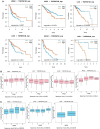Targeting TNFR2: A Novel Breakthrough in the Treatment of Cancer
- PMID: 35494080
- PMCID: PMC9048045
- DOI: 10.3389/fonc.2022.862154
Targeting TNFR2: A Novel Breakthrough in the Treatment of Cancer
Abstract
Tumor necrosis factor (TNF) receptor type II (TNFR2) is expressed in various tumor cells and some immune cells, such as regulatory T cells and myeloid-derived suppressing cells. TNFR2 contributes a lot to the tumor microenvironment. For example, it directly promotes the occurrence and growth of some tumor cells, activates immunosuppressive cells, and supports immune escape. Existing studies have proved the importance of TNFR2 in cancer treatment. Here, we reviewed the activation mechanism of TNFR2 and its role in signal transduction in the tumor microenvironment. We summarized the expression and function of TNFR2 within different immune cells and the potential opportunities and challenges of targeting TNFR2 in immunotherapy. Finally, the advantages and limitations of TNFR2 to treat tumor-related diseases are discussed, and the problems that may be encountered in the clinical development and application of targeted anti-TNFR2 agonists and inhibitors are analyzed.
Keywords: TNFR2; cancer treatment; immune checkpoint; immune response; signaling pathway; tumor immune microenvironment.
Copyright © 2022 Li, Zhang, Bai and Liang.
Conflict of interest statement
The authors declare that the research was conducted in the absence of any commercial or financial relationships that could be construed as a potential conflict of interest.
Figures




Similar articles
-
TNFR2: Role in Cancer Immunology and Immunotherapy.Immunotargets Ther. 2021 Apr 21;10:103-122. doi: 10.2147/ITT.S255224. eCollection 2021. Immunotargets Ther. 2021. PMID: 33907692 Free PMC article. Review.
-
The TNF/TNFR2 signaling pathway is a key regulatory factor in endothelial progenitor cell immunosuppressive effect.Cell Commun Signal. 2020 Jun 16;18(1):94. doi: 10.1186/s12964-020-00564-3. Cell Commun Signal. 2020. PMID: 32546175 Free PMC article.
-
TNFR2: A Novel Target for Cancer Immunotherapy.Trends Mol Med. 2017 Nov;23(11):1037-1046. doi: 10.1016/j.molmed.2017.09.007. Epub 2017 Oct 12. Trends Mol Med. 2017. PMID: 29032004 Review.
-
TNF Receptor 2 Makes Tumor Necrosis Factor a Friend of Tumors.Front Immunol. 2018 May 28;9:1170. doi: 10.3389/fimmu.2018.01170. eCollection 2018. Front Immunol. 2018. PMID: 29892300 Free PMC article. Review.
-
TNFα/TNFR2 signaling pathway: an active immune checkpoint for mesenchymal stem cell immunoregulatory function.Stem Cell Res Ther. 2020 Jul 16;11(1):281. doi: 10.1186/s13287-020-01740-5. Stem Cell Res Ther. 2020. PMID: 32669116 Free PMC article.
Cited by
-
Tumor Necrosis Factor-Alpha and Adiponectin in Nonalcoholic Fatty Liver Disease-Associated Hepatocellular Carcinoma.Cancers (Basel). 2023 Nov 6;15(21):5306. doi: 10.3390/cancers15215306. Cancers (Basel). 2023. PMID: 37958479 Free PMC article. Review.
-
Elevation of circulating TNF receptor 2 in cancer: A systematic meta-analysis for its potential as a diagnostic cancer biomarker.Front Immunol. 2022 Nov 16;13:918254. doi: 10.3389/fimmu.2022.918254. eCollection 2022. Front Immunol. 2022. PMID: 36466914 Free PMC article.
-
Tumor Necrosis Factor Receptor-2 Signals Clear-Cell Renal Carcinoma Proliferation via Phosphorylated 4E Binding Protein-1 and Mitochondrial Gene Translation.Am J Pathol. 2024 Jul;194(7):1374-1387. doi: 10.1016/j.ajpath.2024.02.019. Epub 2024 Mar 25. Am J Pathol. 2024. PMID: 38537932 Free PMC article.
-
Analysis of the diagnostic accuracy of plasma sTNFr-2 concentrations in identifying sarcopenia in community-dwelling older women.Sci Rep. 2025 Jun 4;15(1):19545. doi: 10.1038/s41598-025-95368-1. Sci Rep. 2025. PMID: 40468004 Free PMC article.
-
Neurological Side Effects of TNF-α Inhibitors Revisited: A Review of Case Reports.Medicina (Kaunas). 2024 Aug 28;60(9):1409. doi: 10.3390/medicina60091409. Medicina (Kaunas). 2024. PMID: 39336450 Free PMC article. Review.
References
-
- Fotin-Mleczek M, Henkler F, Samel D, Reichwein M, Hausser A, Parmryd I, et al. . Apoptotic Crosstalk of TNF Receptors: TNF-R2-Induces Depletion of TRAF2 and IAP Proteins and Accelerates TNF-R1-Dependent Activation of Caspase-8. J Cell Sci (2002) 115:2757–70. doi: 10.1242/jcs.115.13.2757 - DOI - PubMed
Publication types
LinkOut - more resources
Full Text Sources
Other Literature Sources

